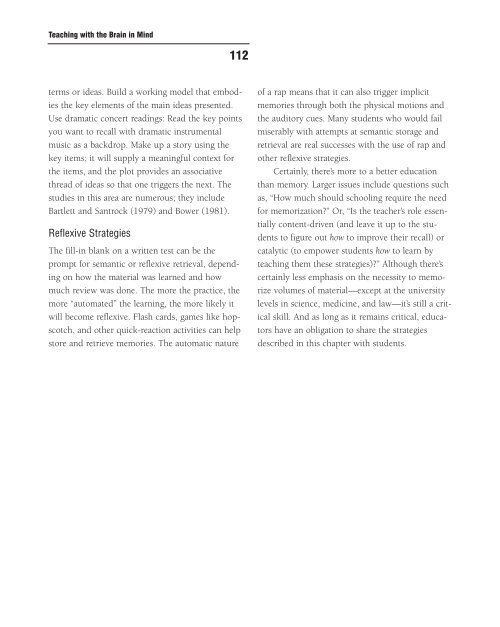You also want an ePaper? Increase the reach of your titles
YUMPU automatically turns print PDFs into web optimized ePapers that Google loves.
<strong>Teach<strong>in</strong>g</strong> with <strong>the</strong> <strong>Bra<strong>in</strong></strong> <strong>in</strong> M<strong>in</strong>d<br />
terms or ideas. Build a work<strong>in</strong>g model that embodies<br />
<strong>the</strong> key elements of <strong>the</strong> ma<strong>in</strong> ideas presented.<br />
Use dramatic concert read<strong>in</strong>gs: Read <strong>the</strong> key po<strong>in</strong>ts<br />
you want to recall with dramatic <strong>in</strong>strumental<br />
music as a backdrop. Make up a story us<strong>in</strong>g <strong>the</strong><br />
key items; it will supply a mean<strong>in</strong>gful context for<br />
<strong>the</strong> items, and <strong>the</strong> plot provides an associative<br />
thread of ideas so that one triggers <strong>the</strong> next. The<br />
studies <strong>in</strong> this area are numerous; <strong>the</strong>y <strong>in</strong>clude<br />
Bartlett and Santrock (1979) and Bower (1981).<br />
Reflexive Strategies<br />
112<br />
The fill-<strong>in</strong> blank on a written test can be <strong>the</strong><br />
prompt for semantic or reflexive retrieval, depend<strong>in</strong>g<br />
on how <strong>the</strong> material was learned and how<br />
much review was done. The more <strong>the</strong> practice, <strong>the</strong><br />
more “automated” <strong>the</strong> learn<strong>in</strong>g, <strong>the</strong> more likely it<br />
will become reflexive. Flash cards, games like hopscotch,<br />
and o<strong>the</strong>r quick-reaction activities can help<br />
store and retrieve memories. The automatic nature<br />
of a rap means that it can also trigger implicit<br />
memories through both <strong>the</strong> physical motions and<br />
<strong>the</strong> auditory cues. Many students who would fail<br />
miserably with attempts at semantic storage and<br />
retrieval are real successes with <strong>the</strong> use of rap and<br />
o<strong>the</strong>r reflexive strategies.<br />
Certa<strong>in</strong>ly, <strong>the</strong>re’s more to a better education<br />
than memory. Larger issues <strong>in</strong>clude questions such<br />
as, “How much should school<strong>in</strong>g require <strong>the</strong> need<br />
for memorization?” Or, “Is <strong>the</strong> teacher’s role essentially<br />
content-driven (and leave it up to <strong>the</strong> students<br />
to figure out how to improve <strong>the</strong>ir recall) or<br />
catalytic (to empower students how to learn by<br />
teach<strong>in</strong>g <strong>the</strong>m <strong>the</strong>se strategies)?” Although <strong>the</strong>re’s<br />
certa<strong>in</strong>ly less emphasis on <strong>the</strong> necessity to memorize<br />
volumes of material—except at <strong>the</strong> university<br />
levels <strong>in</strong> science, medic<strong>in</strong>e, and law—it’s still a critical<br />
skill. And as long as it rema<strong>in</strong>s critical, educators<br />
have an obligation to share <strong>the</strong> strategies<br />
described <strong>in</strong> this chapter with students.



